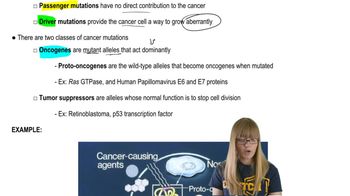Table of contents
- 1. Introduction to Genetics51m
- 2. Mendel's Laws of Inheritance3h 37m
- 3. Extensions to Mendelian Inheritance2h 41m
- 4. Genetic Mapping and Linkage2h 28m
- 5. Genetics of Bacteria and Viruses1h 21m
- 6. Chromosomal Variation1h 48m
- 7. DNA and Chromosome Structure56m
- 8. DNA Replication1h 10m
- 9. Mitosis and Meiosis1h 34m
- 10. Transcription1h 0m
- 11. Translation58m
- 12. Gene Regulation in Prokaryotes1h 19m
- 13. Gene Regulation in Eukaryotes44m
- 14. Genetic Control of Development44m
- 15. Genomes and Genomics1h 50m
- 16. Transposable Elements47m
- 17. Mutation, Repair, and Recombination1h 6m
- 18. Molecular Genetic Tools19m
- 19. Cancer Genetics29m
- 20. Quantitative Genetics1h 26m
- 21. Population Genetics50m
- 22. Evolutionary Genetics29m
17. Mutation, Repair, and Recombination
Types of Mutations
Problem 1c
Textbook Question
Identify the normal functions of the following genes whose mutations are associated with the development of cancer.
Which of these genes would you classify as a proto-oncogene and which as a tumor suppressor gene? Explain your categorization for each gene.
 Verified step by step guidance
Verified step by step guidance1
span>1. Understand the role of proto-oncogenes and tumor suppressor genes in cancer development. Proto-oncogenes are genes that normally help cells grow. When a proto-oncogene mutates (changes) or there are too many copies of it, it becomes a 'bad' gene that can become permanently activated when it is not supposed to be. When this happens, the cell grows out of control, which can lead to cancer. Tumor suppressor genes, on the other hand, are normal genes that slow down cell division, repair DNA mistakes, or tell cells when to die (a process known as apoptosis or programmed cell death). When tumor suppressor genes don't work properly, cells can grow out of control, which can lead to cancer.</span
span>2. Identify the normal functions of the genes in question. For example, if a gene is involved in promoting cell division or growth, it is likely a proto-oncogene. If a gene is involved in inhibiting cell division, repairing DNA, or inducing apoptosis, it is likely a tumor suppressor gene.</span
span>3. Classify each gene based on its normal function. If the gene's normal function is to promote cell growth and division, classify it as a proto-oncogene. If its normal function is to inhibit cell growth, repair DNA, or induce apoptosis, classify it as a tumor suppressor gene.</span
span>4. Provide an explanation for each classification. For example, if a gene is classified as a proto-oncogene, explain that its normal role is to promote cell growth and division, and that mutations can lead to uncontrolled cell proliferation. If a gene is classified as a tumor suppressor gene, explain that its normal role is to inhibit cell growth, repair DNA, or induce apoptosis, and that mutations can lead to a loss of these functions.</span
span>5. Consider the implications of these classifications for cancer treatment. Understanding whether a gene is a proto-oncogene or a tumor suppressor gene can help in developing targeted therapies. For example, therapies that inhibit the activity of oncogenes or restore the function of tumor suppressor genes could be effective in treating certain types of cancer.</span
Recommended similar problem, with video answer:
 Verified Solution
Verified SolutionThis video solution was recommended by our tutors as helpful for the problem above
Video duration:
3mPlay a video:
Was this helpful?
Key Concepts
Here are the essential concepts you must grasp in order to answer the question correctly.
Proto-oncogenes
Proto-oncogenes are normal genes that play a crucial role in cell growth and division. When mutated, they can become oncogenes, leading to uncontrolled cell proliferation and cancer. Examples include genes that code for growth factors, receptors, or signaling molecules that promote cell division.
Recommended video:
Guided course

Cancer Mutations
Tumor Suppressor Genes
Tumor suppressor genes are responsible for regulating cell division and maintaining genomic stability. They act as a brake on cell growth, and mutations that inactivate these genes can lead to cancer. A well-known example is the TP53 gene, which encodes a protein that helps prevent the formation of tumors.
Recommended video:
Guided course

Mapping Genes
Cancer Development
Cancer development is a complex process involving genetic mutations that disrupt normal cellular functions. This can include the activation of proto-oncogenes and the inactivation of tumor suppressor genes, leading to uncontrolled cell growth and the potential for metastasis. Understanding these mechanisms is essential for cancer research and treatment.
Recommended video:
Guided course

Cancer Characteristics

 9:49m
9:49mWatch next
Master Point Mutations with a bite sized video explanation from Kylia Goodner
Start learning



